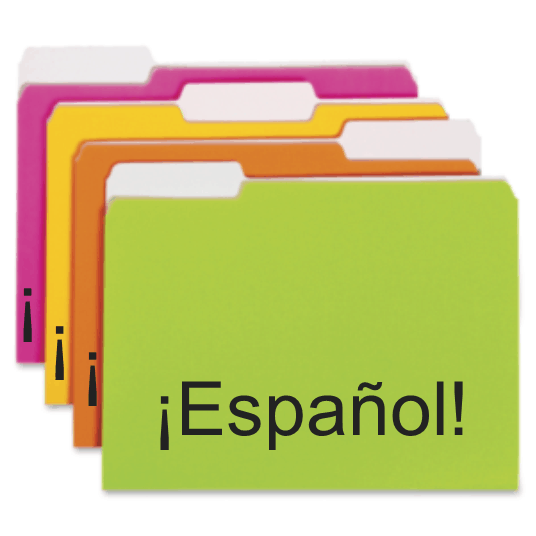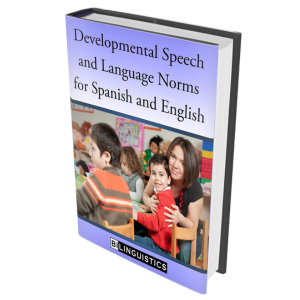
It’s one thing to speak Spanish, it’s another thing to have field-specific vocabulary to talk about speech disorders in Spanish. Whether you are a fluent Spanish speaker, a novice Spanish speaker, or a non-Spanish speaker, as a speech-language pathologist you will need to be able to describe speech disorders in Spanish at some point in your career.
Below you’ll find several lists of words used to talk about communication development and communication disorders in Spanish. We’ve included a list of phonological processes in English and Spanish. You will also find English terms and their Spanish translations to describe articulation skills and articulation goals. These will come in handy during IEP meetings and when reviewing evaluations and progress with families.
Talking about Phonological Processes in Spanish
Let’s start with Spanish phonological processes. When talking about phonological processes in English we might share with a parent that,
Phonological processes are normal patterns that occur in developing speech due to motor constraints. Children stop using some patterns around age three and other patterns are used longer. It’s when these patterns are used past the point at which most children stop using them that they are considered a problem.
And for our Spanish-speaking parents, we might share that,
Los procesos fonológicos son patrones normales que ocurren en el desarrollo del habla mientras que el sistema de articulación madura. Los niños dejan de usar algunos patrones alrededor de los tres años y otros patrones se usan por más tiempo. Es cuando estos patrones se usan más de lo normal que se consideran un problema.
| English | Spanish |
|---|---|
| Final consonant deletion | Supresión de consonantes finales |
| Initial consonant deletion | Supresión de consonantes iniciales |
| Medial consonant deletion | Supresión de consonantes mediales |
| Weak syllable deletion | Supresión de sílabas átonas |
| Reduplication | Reduplicación |
| Consonant Cluster Reduction | Reducción de grupos consonánticos |
| Assimilation | Asimilación |
| Fronting | Anteriorización |
| Backing | Posteriorización |
| Gliding of liquids | Deslizamiento de consonantes líquidas |
| Syllable Reduction | Reducción de sílabas |
| Stopping | Oclusivización |
| Devoicing | Ensordecimiento |
| Voicing | Sonorización |
| Nasalization of vowels | Nasalización de vocales |
And here’s a great chart with English and Spanish developmental norms that you can include in your reports.
This chart provides examples of different processes in English and Spanish and some guidelines for when phonological processes are suppressed. Remember that with any charts of development, there is a lot of variation in children and studies. Use them as guidelines to inform your evaluation and to guide your dynamic assessment process and evaluation of stimulability.
Phonological Processes Chart
| Suppressed by: | Pattern | English Example | Spanish Example | |
|---|---|---|---|---|
| Spanish * | English* | Syllabic Patterns | ||
| Age 3 (rare) | Age 3 (rare) | Initial Consonant Deletion | “at” for “cat” | “an” for “pan” |
| Age 3 | Age 3 | Final Consonant Deletion | “ca” for “cat” | “lapi” for “lapiz” |
| Age 3 | Age 4 | Medial Consonant Deletion | “ki-y” for “kitty” | “la-iz” for “lapis” |
| Age 5 | Age 4 | Cluster Reduction | “fat” for “flat” | “faco” for “flaco” |
| Age 3 | Age 4 | Weak Syllable Deletion | “telphone” for “telephone” | “tefono” for “telefono” |
| Substitution Patterns | ||||
| Age 5 | Age 3 | Stopping | “bat” for “fat” | “cape” for “café” |
| Age 3 | Age 4 | Fronting | “bat” for “kat” | “teso” for “queso” |
| Age 3 | Age 3 | Assimilation | “tato” for “taco” | “tato” for “taco” |
| Age 3 | Age 3 | Backing | “kat” for “bat” | “kos” for “dos” |
| Age 5 | Age 7 | Liquid Simplification | “wake” for “lake” | “wapiz” for “lapis” |
| NA | Age 7 | Vocalization | “powah” for “power” | NA |
| Age 5 | NA | Flap/Trill Deviation | NA | “daton” for “raton” |
| Age 5 | Age 7 | Gliding | “bwack” for “black” | “pwato” for “plato” |
* Based on the work of Goldstein (Spanish) and Shriberg (English).
For more information about phonological processes in Spanish and speech disorders in Spanish, check out this ASHA article and this great resource.
Let’s talk about how we describe articulation disorders in Spanish.
With articulation, we are often describing where a sound is made and how a sound is made. In speech lingo, that’s place and manner of production. Below is a table of frequent terminology we use to talk about articulation disorders in English and Spanish.
When we talk to parents about articulation disorders we might say,
Articulation deals with the way we use our lips, tongue, and teeth to produce different sounds. When we evaluate articulation skills, we look to see if there is a particular sound or type of sound that is difficult to produce. We talk about these sounds by the place they are articulated and by the way we make them.
In Spanish, that would sound like this:
La articulación se trate de la forma en que usamos los labios, la lengua, y los dientes para producir diferentes sonidos. Cuando evaluamos las habilidades de articulación, investigamos si hay un sonido espicífico o un tipo de sonido que es difícil de producir. Hablamos de estos sonidos por el lugar en que se articulan y por la forma en que los hacen.
Chart of Articulation Terms in Spanish and English
| English | Spanish |
| Palatal | Palatal |
| Velar | Velar |
| Fricative | Fricativa |
| Affricate | Africada |
| Voiced | Sonoro |
| Voiceless | Insonoro |
| Nasal | Nasal |
| Liquid | Líquido |
| Stop/Plosive | Oclusivo |
Talking about Speech Goals in Spanish
After we talk to parents about our concerns about their child’s speech development, we talk about goals and how we are going to work on the areas of need. Here are some of the ways we talk about speech goals in Spanish.
In English, our conversation with parents might sound like this:
Your child is currently demonstrating articulation/phonology skills that are below average compared to other children his/her age. We have selected goals to address his/her areas of difficulty.
And in Spanish…
Su hijo actualmente está demostrando habilidades de articulación/fonología que están bajo del promedio en comparación con otros niños de su edad. Hemos seleccionado objetivos para ayudar con sus areas de necesidad.
Terms for Articulation Goals in Spanish and English
| Articulation Goals | Metas de articulación |
| Discriminate correct and incorrect sounds | Distinguir los sonidos correctos e incorrectos |
| Produce in isolation | Producir en aislamiento |
| Produce in syllables | Producir en sílabas |
| Produce in word initial position | Producir en posición inicial de palabras |
| Produce in word medial position | Producir en posición medial de palabras |
| Produce in word final position | Producir en posición final de palabras |
| Produce in consonant clusters | Producir en grupos consonánticos |
| Use in phrases and sentences | Usar en frases y oraciones |
| Use consistently in conversation | Usar consistentemente durante la conversación |
Spanish Stuttering Vocabulary
Fluency terms in Spanish are hard to come by and are best used with examples if you are explaining goals or processes to parents or teachers. Simply translating vocabulary might not get the meaning across because even in English, someone might not understand what we mean by revisions, and vocal tension. So use these translations of stuttering terms into Spanish to facilitate not only the use of the word but also the description of the process.
| Fluency | La fluidez |
| Stuttering | El tartamudeo |
| Recite importance and value of fluency | Decir la importancia y valor de fluidez |
| Describe and reduce types of dysfluencies: | Describir y reducir la clase de errores de fluidez: |
| Revisions | Las revisiones |
| Fillers | Las interrupciones |
| Describe/demonstrate strategies that facilitate speech | Describir y demostrar estrategias que facilitan el habla |
| Demonstrate fluency during: | Demostrar fluidez durante: |
| Words | Las palabras |
| Sentences | Las oraciones |
| Reading | La lectura |
| Conversation | La conversación |
| Reduce rate to within normal limits | Reducir la velocidad del habla dentro de los límites apropiados |
| Maintain eye contact | Mantener contacto visual |
| Identify and describe secondary characteristics: | Identificar y describir caracteristicas secundarias: |
| Posturing | La postura |
| Respiration | la respiración |
| Facial grimaces | los gestos faciales |
| Vocal tension | La tensión vocal |
| List ways to reduce stress | Listar diferentes formas de reducir tensión |
| Identify/describe situations and behaviors that increase dysfluency | Identificar y describir comportamientos secundarios que incrementan los errores de fluidez |
| Generalize fluency outside of the therapy room | Generalizar la fluidez en lugares fuera del salón de terapia |
Voice Disorder Spanish Terms
And if Spanish stuttering terms were hard to come by, what about Spanish voice disorder translations?! Just like with fluency translations, use this list to facilitate understanding in meetings when you are trying to explain why the client’s voice is different and what goals you are going to focus on to help.
Vocal Nasality
| Recite and explain importance of speech goals | Decir y explicar la importancia de la meta de voz/habla |
| Strengthen velum by producing syllable with voiceless consonants and high vowels | Reforzar el velo del paladar al producir sílabas con consonantes sordas y vocales altas |
| Discriminate between appropriate voice quality and hypernasality/nasal emission | Distinguir entre la cualidad de voz apropiada e hipernasalidad/emisión nasal |
| Identify appropriate vocal quality in self when reading/repeating non-nasal words/sentences | Identificar en si mismo la cualidad apropiada de la voz durante actividades de lectura/repetición de palabras u oraciones que no son nasales. |
| Have parents rate student voice quality | Pida a los padres el favor de evaluar la cualidad de la voz del estudiante |
| Identify times when using inappropriate vocal quality | Identificar los momentos cuando se este usando una cualidad de voz inapropiada |
| Increase oral resonance by using exaggerated open mouth movements and low vowels in: Syllables, words, sentences, conversation | Aumentar resonancia oral por medio de movimientos exagerados de la boca y usando vocales bajas en: sílabas, palabras, oraciones, conversación |
Voice Quality
| Write or recite goal for improving vocal use | Escribir o decir la meta para mejorar el uso de la voz |
| Understand normal and abnormal function of the larynx | Comprender las funciones normales y anormales de la laringe Identify forms of vocal abuseIdentificar las diferentes formas de abuso de la voz |
| Identify and order situations where abuse occurs | Identificar y poner en orden las direrentes situaciones en que abuso de la voz puede ocurrir. |
| Describe strategies for controlling vocal abuse | Describir estrategias para controlar el abuso vocal |
| Identify and reduce hard glottal attack | Identificar y reducir el ataque glotal duro |
| Use the yawn/sigh approach | Describir estrategias para controlar el mal uso/abuso de la voz |
| Apply techniques of proper vocal use 30 minutes a day 1 hour a day gradually increasing periods | Aplicar tecnicas vocales apropiadas por 30 minutos al dia 1 hora al dia gradualmente aumentar los periodos de uso |
| Apply techniques of proper vocal use in school and home situations | Aplicar tecnicas de uso vocal apropiado en la escuela y en la casa |
And to wrap this up, here are a few more great resources.
Talking to Spanish-speaking parents about speech disorders
The Goal Bank with Goals Written in English and Spanish
Spanish Wording for Parent Conferences




Thank you for providing these!
Glad they helped!
This is awesome. I appreciate the translations. The only one I feel needs to be corrected for incorrect spelling in the Spanish form is: Devoiced to Ensordecimiento (with a c, instead of an s as written here).
Thanks! I made the change. It takes a village…
Scott